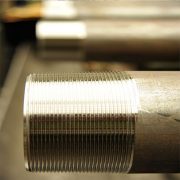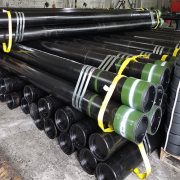Öljynporausprojekteissa käytettyjen suojaputkien kierremittarit
Öljy- ja kaasuteollisuudessa vaippaputkilla on ratkaiseva rooli kaivojen rakenteellisen eheyden ylläpitämisessä porauksen aikana. Näiden kaivojen turvallisen ja tehokkaan toiminnan varmistamiseksi vaippaputkien kierteet on valmistettava tarkasti ja tarkastettava perusteellisesti. Tässä kierremittareista tulee välttämättömiä.
Vaippaputkien kierremittarit auttavat varmistamaan oikean kierteityksen, mikä vaikuttaa suoraan öljykaivojen suorituskykyyn ja turvallisuuteen. Tässä blogissa tutkimme kierremittojen merkitystä, kuinka niitä käytetään öljynporausprojekteissa ja kuinka ne auttavat ratkaisemaan alan yleisiä ongelmia.
1. Mitä ovat lankamittarit?
Kierremittarit ovat tarkkuusmittaustyökaluja, joita käytetään varmistamaan kierrekomponenttien mittojen tarkkuus ja sopivuus. Öljynporauksen yhteydessä ne ovat välttämättömiä koteloputkien kierteiden tarkastamiseksi sen varmistamiseksi, että ne täyttävät alan standardit ja muodostavat turvalliset, tiiviit liitokset kaivoon.
Kierremittareiden tyypit:
- Rengasmittarit: Käytetään putken ulkokierteiden tarkistamiseen.
- Pistokemittarit: Käytetään putken tai kytkimen sisäkierteiden tarkastamiseen.
- Satulan tyyppiset mittarit: Nämä mittarit mittaavat langan halkaisijan varmistaen oikean koon ja istuvuuden.
- API säiemittarit: Suunniteltu erityisesti täyttämään American Petroleum Instituten (API) öljy- ja kaasusovelluksiin asettamat standardit.
2. Päällysputkien rooli öljynporauksessa
Vaippaputkia käytetään kaivon reiän vuoraukseen porauksen aikana ja sen jälkeen. Ne antavat kaivolle rakenteellisen eheyden ja estävät pohjaveden saastumisen sekä varmistavat, että öljy tai kaasu poistetaan turvallisesti säiliöstä.
Öljykaivoja porataan useissa vaiheissa, joista jokainen vaatii erikokoisen vaippaputken. Nämä putket yhdistetään päästä päähän kierreliittimillä, jotka muodostavat turvallisen ja jatkuvan kotelonauhan. Näiden kierreliitosten tarkkuuden ja turvallisuuden varmistaminen on erittäin tärkeää vuotojen, räjähdysten ja muiden vikojen estämiseksi.
3. Miksi kierremittarit ovat tärkeitä öljynporauksessa?
Öljynporauksessa kohdatut ankarat olosuhteet – korkeat paineet, äärimmäiset lämpötilat ja syövyttävät ympäristöt – vaativat tarkkuutta jokaiselta komponentilta. Kierremittarit varmistavat, että kotelon putkien kierteet ovat toleranssin sisällä, mikä auttaa:
- Varmista varma istuvuus: Oikein mitatut kierteet varmistavat, että putket ja liittimet sopivat tiiviisti yhteen, mikä estää vuodot, jotka voivat johtaa kalliisiin seisokkiin tai ympäristövahinkoihin.
- Estä hyvin epäonnistuminen: Huonosti kierreliitännät ovat yksi johtavista syistä kaivon eheysongelmiin. Kierremittarit auttavat tunnistamaan valmistusvirheet varhaisessa vaiheessa ja ehkäisevät katastrofaaliset viat porauksen aikana.
- Säilytä turvallisuus: Öljynporauksessa turvallisuus on ensiarvoisen tärkeää. Kierremittarit varmistavat, että kotelon liitännät ovat riittävän lujia kestämään syvällä maan alla kohdattavat korkeat paineet, mikä suojaa työntekijöitä ja laitteita mahdollisesti vaarallisilta tilanteilta.
4. Miten kierremittareita käytetään öljynporausprojekteissa?
Kierremittareita käytetään öljynporausprojektin eri vaiheissa vaippaputkien valmistuksesta kenttätarkastuksiin. Alla on vaiheittainen yleiskatsaus niiden käyttöön:
1. Valmistuksen tarkastus:
Tuotannon aikana vaippaputket ja liittimet valmistetaan tarkalla kierteellä varman istuvuuden varmistamiseksi. Kierremittareita käytetään koko tämän prosessin ajan varmistamaan, että kierteet täyttävät vaaditut standardit. Jos jokin lanka putoaa toleranssin ulkopuolelle, se joko työstetään uudelleen tai hylätään tulevien ongelmien välttämiseksi.
2. Kenttätarkastus:
Ennen kuin koteloputket lasketaan porausreikään, kenttäinsinöörit tarkastavat sekä putket että liittimet kierremittareiden avulla. Tämä varmistaa, että kierteet ovat edelleen toleranssien sisällä eivätkä ole vaurioituneet kuljetuksen tai käsittelyn aikana.
3. Uudelleenkalibrointi ja huolto:
Itse kierremittarit on kalibroitava säännöllisesti jatkuvan tarkkuuden varmistamiseksi. Tämä on erityisen tärkeää öljyteollisuudessa, jossa pienikin poikkeama kierteittämisessä voi johtaa kalliisiin vaurioihin.
5. Tärkeimmät kierteitysstandardit öljy- ja kaasuteollisuudessa
Kierremittareiden on täytettävä tiukat alan standardit varmistaakseen yhteensopivuuden ja turvallisuuden öljy- ja kaasutoimissa. Yleisimmin käytetyt vaippaputkien standardit määrittelevät American Petroleum Institute (API), joka säätelee kotelon, putkien ja putkien kierteiden tekniset tiedot. Näitä ovat:
- API 5B: Määrittää mitat, toleranssit ja vaatimukset kotelon, putkien ja putkien kierteiden tarkastukselle.
- API 5CT: Hallitsee öljykaivojen kotelon ja putkien materiaaleja, valmistusta ja testausta.
- API tukisäikeet (BTC): Näitä kierteitä käytetään yleisesti kotelointiputkissa, ja niillä on suuri kantava pinta ja ne ovat ihanteellisia korkean jännityksen ympäristöihin.
Näiden standardien noudattamisen varmistaminen on erittäin tärkeää, koska ne on suunniteltu suojaamaan öljy- ja kaasulähteiden eheyttä äärimmäisissä käyttöolosuhteissa.
6. Yleisiä haasteita putkien kierteittämisessä ja miten kierremittarit auttavat
1. Kierrevauriot kuljetuksen aikana:
Vaippaputket kuljetetaan usein syrjäisiin paikkoihin, ja käsittely voi vaurioitua. Kierremittarit mahdollistavat kenttätarkastuksen ja varmistavat, että vaurioituneet kierteet tunnistetaan ja korjataan ennen kuin putket lasketaan kaivoon.
2. Langan kuluminen ajan myötä:
Joissakin tapauksissa kotelon nauhat on ehkä poistettava ja käytettävä uudelleen. Ajan myötä kierteet voivat kulua, mikä vaarantaa liitoksen eheyden. Kierremittarit voivat havaita kulumisen, jolloin insinöörit voivat päättää, voidaanko koteloputkea käyttää uudelleen vai tarvitaanko uusia putkia.
3. Yhteensopimattomat ketjut:
Eri kotelon valmistajilla voi olla pieniä eroja kierteittämisessä, mikä voi johtaa mahdollisiin ongelmiin, kun eri lähteistä peräisin olevia putkia käytetään samassa kaivossa. Kierremittarit voivat auttaa tunnistamaan yhteensopimattomuudet ja varmistamaan, että kaikki käytetyt putket ovat yhteensopivia keskenään.
4. Laadunvarmistus:
Kierremittarit tarjoavat luotettavan tavan suorittaa laaduntarkistuksia sekä valmistusprosessin että kenttäoperaatioiden aikana, mikä varmistaa johdonmukaisuuden kaikissa projektissa käytettyjen koteloputkien välillä.
7. Parhaat käytännöt kierremittareiden käyttämiseen öljynporauksessa
Kierremittareiden tehokkuuden maksimoimiseksi ja kaivon eheysongelmien riskin minimoimiseksi käyttäjien tulee noudattaa näitä parhaita käytäntöjä:
- Mittareiden säännöllinen kalibrointi: Kierremittarit tulee kalibroida säännöllisesti varmistaakseen, että ne antavat tarkat mittaukset.
- Koulutus teknikoille: Varmista, että kenttä- ja valmistusteknikot ovat asianmukaisesti koulutettuja kierremittareiden käyttöön ja että he voivat tulkita tulokset tarkasti.
- Visuaaliset ja mittausperusteiset tarkastukset: Vaikka kierremittarit tarjoavat tarkkuutta, silmämääräinen tarkastus vaurioiden, kuten kolhujen, korroosion tai kulumisen varalta, on myös kriittinen.
- Tietojen seuranta: Pidä kirjaa kaikista kierteiden tarkastuksista, jotta voit seurata kulumista tai vaurioita ajan myötä, mikä mahdollistaa ennakoivan huollon.
Johtopäätös
Vaippaputkien kierremittarit ovat keskeinen osa öljynporausta, ja ne auttavat varmistamaan, että vaippaputket on kierretty oikein ja täyttävät alan tiukat vaatimukset. Käyttämällä kierremittareita koko valmistus-, kuljetus- ja porausvaiheessa öljy- ja kaasuoperaattorit voivat parantaa projektiensa turvallisuutta, luotettavuutta ja tehokkuutta.
Öljynporauksessa, jossa jokainen liitos on tärkeä, kierremittareiden tarkkuus voi merkitä eroa onnistuneen toiminnan ja kalliin vian välillä. Näiden työkalujen säännöllinen käyttö ja alan standardien noudattaminen takaavat kaivon koteloiden pitkän aikavälin eheyden ja porausprojektin yleisen turvallisuuden.





